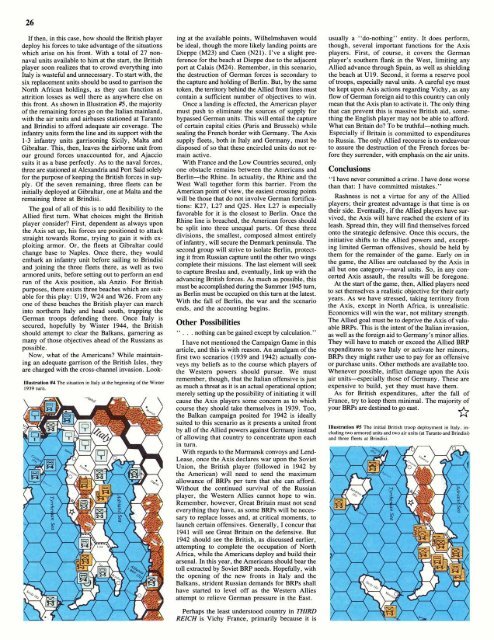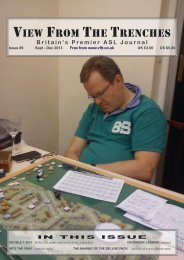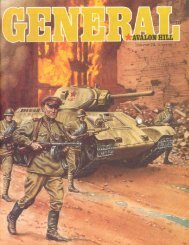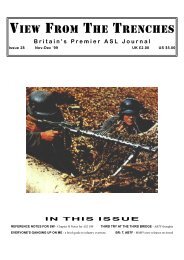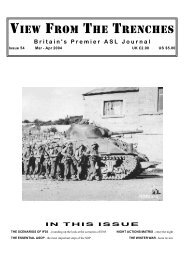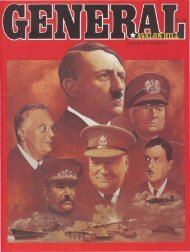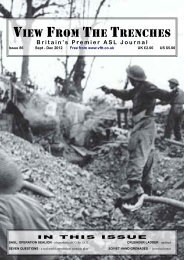18.64MB - View From The Trenches
18.64MB - View From The Trenches
18.64MB - View From The Trenches
- TAGS
- trenches
- www.vftt.co.uk
You also want an ePaper? Increase the reach of your titles
YUMPU automatically turns print PDFs into web optimized ePapers that Google loves.
If then, in this case, how should the British player<br />
deploy his forces to take advantage of the situations<br />
which arise on his front. With a total of 27 non-<br />
naval units available to him at the start, the British<br />
player soon realizes that to crowd everything into<br />
Italy is wasteful and unnecessary. To start with, the<br />
six replacement units should be used to garrison the<br />
North African holdings, as they can function as<br />
attrition losses as well there as anywhere else on<br />
this front. As shown in Illustration #5, the majority<br />
of the remaining forces go on the Italian mainland,<br />
with the air units and airbases stationed at Taranto<br />
and Brindisi to afford adequate air coverage. <strong>The</strong><br />
infantry units form the line and its support with the<br />
1-3 infantry units garrisoning Sicily, Malta and<br />
Gibraltar. This, then, leaves the airborne unit from<br />
our ground forces unaccounted for, and Ajaccio<br />
suits it as a base perfectly. As to the naval forces,<br />
three are stationed at Alexandria and Port Said solely<br />
for the purpose of keeping the British forces in sup-<br />
ply. Of the seven remaining, three fleets can be<br />
initially deployed at Gibraltar, one at Malta and the<br />
remaining three at Brindisi.<br />
<strong>The</strong> goal of all of this is to add flexibility to the<br />
Allied first turn. What choices might the British<br />
player consider? First, dependent as always upon<br />
the Axis set up, his forces are positioned to attack<br />
straight towards Rome, trying to gain it with ex-<br />
ploiting armor. Or, the fleets at Gibraltar could<br />
change base to Naples. Once there, they would<br />
embark an infantry unit before sailing to Brindisi<br />
and joining the three fleets there, as well as two<br />
armored units, before setting out to perform an end<br />
run of the Axis position, ala Anzio. For British<br />
purposes, there exists three beaches which are suit-<br />
able for this play: U19, W24 and W26. <strong>From</strong> any<br />
one of these beaches the British player can march<br />
into northern Italy and head south, trapping the<br />
German troops defending there. Once Italy is<br />
secured, hopefully by Winter 1944, the British<br />
should attempt to clear the Balkans, garnering as<br />
many of those objectives ahead of the Russians as<br />
possible.<br />
Now, what of the Americans? While maintain-<br />
ing an adequate garrison of the British Isles, they<br />
are charged with the cross-channel invasion. Look-<br />
Illustration #4 <strong>The</strong> situation in Italy at the beginning of the Winter<br />
1939 turn.<br />
ing at the available points, Wilhelmshaven would<br />
be ideal, though the more likely landing points are<br />
Dieppe (M23) and Caen (N21). I've a slight pre-<br />
ference for the beach at Dieppe due to the adjacent<br />
port at Calais (M24). Remember, in this scenario,<br />
the destruction of German forces is secondary to<br />
the capture and holding of Berlin. But, by the same<br />
token, the territory behind the Allied front lines must<br />
contain a sufficient number of objectives to win.<br />
Once a landing is effected, the American player<br />
must push to eliminate the sources of supply for<br />
bypassed German units. This will entail the capture<br />
of certain capital cities (Paris and Brussels) while<br />
sealing the French border with Germany. <strong>The</strong> Axis<br />
supply fleets, both in Italy and Germany, must be<br />
disposed of so that these encircled units do not re-<br />
main active.<br />
With France and the Low Countries secured, only<br />
one obstacle remains between the Americans and<br />
Berlin-the Rhine. In actuality, the Rhine and the<br />
West Wall together form this barrier. <strong>From</strong> the<br />
American point of view, the easiest crossing points<br />
will be those that do not involve German fortifica-<br />
tions: K27, L27 and 425. Hex L27 is especially<br />
favorable for it is the closest to Berlin. Once the<br />
Rhine line is breached, the American forces should<br />
be split into three unequal parts. Of these three<br />
divisions, the smallest, composed almost entirely<br />
of infantry, will secure the Denmark peninsula. <strong>The</strong><br />
second group will strive to isolate Berlin, protect-<br />
ing it from Russian capture until the other two wings<br />
complete their missions. <strong>The</strong> last element will seek<br />
to capture Breslau and, eventually, link up with the<br />
advancing British forces. As much as possible, this<br />
must be accomplished during the Summer 1945 turn,<br />
as Berlin must be occupied on this turn at the latest.<br />
With the fall of Berlin, the war and the scenario<br />
ends, and the accounting begins.<br />
Other Possibilities<br />
" . . . nothing can be gained except by calculation."<br />
I have not mentioned the Campaign Game in this<br />
article, and this is with reason. An amalgam of the<br />
first two scenarios (1939 and 1942) actually con-<br />
veys my beliefs as to the course which players of<br />
the Western powers should pursue. We must<br />
remember, though, that the Italian offensive is just<br />
as much a threat as it is an actual operational option;<br />
merely setting up the possibility of initiating it will<br />
cause the Axis players some concern as to which<br />
course they should take themselves in 1939. Too,<br />
the Balkan campaign posited for 1942 is ideally<br />
suited to this scenario as it presents a united front<br />
by all of the Allied powers against Germany instead<br />
of allowing that country to concentrate upon each<br />
in turn.<br />
With regards to the Murrnansk convoys and Lend-<br />
Lease, once the Axis declares war upon the Soviet<br />
Union, the British player (followed in 1942 by<br />
the American) will need to send the maximum<br />
allowance of BRPs per turn that she can afford.<br />
Without the continued survival of the Russian<br />
player, the Western Allies cannot hope to win.<br />
Remember, however, Great Britain must not send<br />
everything they have, as some BRPs will be neces-<br />
sary to replace losses and, at critical moments, to<br />
launch certain offensives. Generally, I concur that<br />
1941 will see Great Britain on the defensive. But<br />
1942 should see the British, as discussed earlier,<br />
attempting to complete the occupation of North<br />
Africa, while the Americans deploy and build their<br />
arsenal. In this year, the Americans should bear the<br />
toll extracted by Soviet BRP needs. Hopefully, with<br />
the opening of the new fronts in Italy and the<br />
Balkans, strident Russian demands for BRPs shall<br />
have started to level off as the Western Allies<br />
attempt to relieve German pressure in the East.<br />
Perhaps the least understood country in THIRD<br />
REICH is Vichy France, primarily because it is<br />
usually a "do-nothing" entity. It does perform,<br />
though, several important functions for the Axis<br />
players. First, of course, it covers the German<br />
player's southern flank in the West, limiting any<br />
Allied advance through Spain, as well as shielding<br />
the beach at U19. Second, it forms a reserve pool<br />
of troops, especially naval units. A careful eye must<br />
be kept upon Axis actions regarding Vichy, as any<br />
flow of German foreign aid to this country can only<br />
mean that the Axis plan to activate it. <strong>The</strong> only thing<br />
that can prevent this is massive British aid, some-<br />
thing the English player may not be able to afford.<br />
What can Britain do? To be truthful-nothing much.<br />
Especially if Britain is committed to expenditures<br />
to Russia. <strong>The</strong> only Allied recourse is to endeavour<br />
to assure the destruction of the French forces be-<br />
fore they surrender, with emphasis on the air units.<br />
Conclusions<br />
"I have never committed a crime. I have done worse<br />
than that: I have committed mistakes."<br />
Rashness is not a virtue for any of the Allied<br />
players; their greatest advantage is that time is on<br />
their side. Eventually, if the Allied players have sur-<br />
vived, the Axis will have reached the extent of its<br />
leash. Spread thin, they will find themselves forced<br />
onto the strategic defensive. Once this occurs, the<br />
initiative shifts to the Allied powers and, except-<br />
ing limited German offensives, should be held by<br />
them for the remainder of the game. Early on in<br />
the game, the Allies are outclassed by the Axis in<br />
all but one category-naval units. So, in any con-<br />
certed Axis assault, the results will be foregone.<br />
At the start of the game, then, Allied players need<br />
to set themselves a realistic objective for their early<br />
years. As we have stressed, taking territory from<br />
the Axis, except in North Africa, is unrealistic.<br />
Economics will win the war, not military strength.<br />
<strong>The</strong> Allied goal must be to deprive the Axis of valu-<br />
able BRPs. This is the intent of the Italian invasion,<br />
as well as the foreign aid to Germany's minor allies.<br />
<strong>The</strong>y will have to match or exceed the Allied BRP<br />
expenditures to save Italy or activate her minors,<br />
BRPs they might rather use to pay for an offensive<br />
or purchase units. Other methods are available too.<br />
Whenever possible, inflict damage upon the Axis<br />
air units-especially those of Germany. <strong>The</strong>se are<br />
expensive to build, yet they must have them.<br />
As for British expenditures, after the fall of<br />
France, try to keep them minimal. <strong>The</strong> majority of<br />
your BRPs are destined to go east. *<br />
Illustration #S <strong>The</strong> initial British troop deployment in Italy, in-<br />
cluding two armored units and two air units (at Taranto and Brindisi)<br />
and three fleets at Brindisi.


